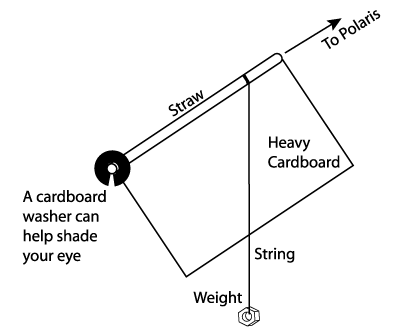Size of the Earth
Project for Elementary Astronomy
It is relatively easy to measure the size of the Earth using simple tools at
your disposal: straws, string, brains, and feet. In this activity you will
follow in the footsteps of Eratosthenes, a Greek
astronomer of the third century BC. Eratosthenes' method involved
observations of the Sun on a specific day (the summer solstice); you will instead
use the fixed position of the star Polaris.
This activity can be done only if you are going to be traveling
150 miles or more due north or south this semester--the farther the
better. Neither Price nor Pocatello is quite far enough, but Richfield
or Rexburg is adequate. This is a great project if you are planning
such a trip already. You'll also need to have clear weather at night when at your
destination (and at home).
To conduct this observing project, follow this procedure:
- Construct your low-tech equivalent of an
astrolabe as shown in the figure below. You'll need a
sheet of heavy cardboard or posterboard (about the size of a sheet of
paper), a drinking straw, string, a heavy washer or other weight, and some
tape.
- Tie one end of your string about 2/3 of
the distance down the straw. Tape the straw firmly to the top edge of
the cardboard, allowing the string to hang down on one side. Tie
the heavy weight to the free end of the string, so the string hangs
vertically when the cardboard is held vertically with the straw on
top.

A cousin to the astrolabe that you can build in your kitchen.
- You will be observing the star Polaris
(the North Star) from your two different locations. The two
observations should be done at about the same time of night, and
within a week or two of each other (Polaris does in fact move a
small amount; keeping the observations similar will reduce error
from the motion of Polaris).
- To make your observations, on a clear
night hold the cardboard vertically, and sight Polaris through the
straw. Once you are certain you are looking at Polaris, mark the
position of the string without moving the cardboard; you can either
clamp down on the string so you can mark it yourself, or get a
trustworthy assistant to help you mark it. Label the line with
your location, and the time and date of your observation.
- Repeat this observation
at both the northern and southern locations. When finished,
you should have two straight lines that cross each other where the
string is tied to the straw. Your scientific data is the
angle between these two lines.
- Your measurements can give surprisingly
good results if you're very careful in the sighting and marking.
Depending on how far north or south you travel, the difference in
angles will be very small; even small errors will lead to major
difference between your value and the true value of the size of the
Earth. Don't fret over this too much; just be aware that great
care is needed for accurate measurements.
To complete the project, include the following in your analysis:
- Using a map, measure the north-south
distance between your two observing locations. This will be less
than your actual travel distance, unless you traveled exactly
straight north or south, which is highly unlikely since we're not
in Kansas and roads weave
about. (If we were in Kansas and you drove directly north
or south, you could just use your car's odometer for this measurement
and you wouldn't need a map.)
Attach a copy of your map, suitably marked, to your report.
Be sure that your copy shows the map scale.
- Using a protractor, measure the angle
between the two vertical lines on your device. The lines cross
because the direction of "vertical", measured relative to the
stars, has changed as you moved around Earth's surface. The angle
between the lines is the number of degrees of latitude that you
have moved.
- To figure the circumference of the Earth,
divide 360° by the angle between your lines. This is the ratio by which
the full circumference of the earth is bigger than the distance you traveled.
Multiply the north-south distance you traveled by this
ratio; the result should be close to the circumference of the
Earth. Round off your answer appropriately (to the nearest
500-1000 miles, depending on how accurate you think your
measurements were). Show and explain your calculations in your report.
- Look up the circumference of the Earth.
Note that it might be easier to find the radius or
diameter, from which you can compute the circumference
using π. By what percentage does your result differ from the
official value? (Show this calculation.) How could you make your answer agree better?
- Please attach your measuring
device to your report, along with the notes and lines you drew on it.
(You may remove the weight.)
- Be sure to follow the general instructions applicable
to all projects.

